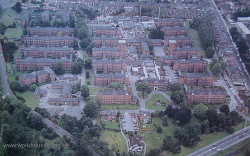Tooting Bec Asylum
| Tooting Bec Asylum | |
|---|---|
 | |
| Established | 1894 |
| Construction Began | 1899 |
| Opened | 1903 |
| Closed | 1995 |
| Demolished | 1997 |
| Current Status | Demolished |
| Building Style | Pavilion Plan |
| Architect(s) | A & C Harston |
| Location | South London |
| Alternate Names |
|
History[edit]
A 28-acre site in Tooting Graveney, formerly part of the Tooting Lodge estate, was purchased in 1894 for £27,000. Construction work began in 1899, to the same design as the Leavesden and Caterham Asylums - two rows of ward blocks either side of a central administration building. The Tooting Bec Asylum opened in 1902, but the first patients were not admitted until January 1903. It had 1000 beds and had cost just over £20,000 to build. The 3-storey ward blocks contained a 24-bedded ward on each floor. Nine ward blocks had been planned but only seven were built; there were four for female patients (instead of five) and three for males (instead of four). These blocks were connected to each other by long covered walkways. Fire-escape bridges connected the first and second floors of each ward block to its neighbour, and these served as verandahs for bed-ridden patients to sit out on during fine weather. The 4-storey central block contained offices and staff rooms, while a single-storey section at the rear contained storerooms, a laundry, domestic staff quarters, a boiler house, gas works and dynamo house. At the north of the site were two 3-storey Nurses' Homes.
The Asylum was designated to be used for infirm epileptics, patients with senile dementia and others 'requiring exceptional individual attention'. Its location at a less remote site had been chosen specifically so that its elderly inmates could be near family and friends. Originally it had been planned immediately to transfer patients from the three overcrowded Asylums, but in February patients from Colney Hatch Asylum had to be temporarily accommodated at Tooting Bec following a serious fire.
In 1906 the two ward blocks which had not been built in 1902 were added to the site. A recreation hall, which doubled as a chapel, was also erected between the laundry and the domestic staff quarters. A separate block was built on the eastern side of the site as a Receiving Home for children; this had a central 2-storey administration block and 5 single-storey ward blocks. In 1914, just before the outbreak of WW1, M.A.B. decided to double the bed accommodation to 2200 beds. Bushey Down House, a large mansion to the southwest of the Asylum, was bought and demolished for the expansion. Building work ceased in 1916 because of the war, but resumed again in 1919.
In 1924 the first part of the extension was finished - four villas for female patients, containing two wards of 30 beds each on each floor. There were also 32 single rooms. The new blocks had verandahs on the ground floor and fire escape bridges on the upper floors. A Nurses' Home for 112 nurses was also built, and the recreation room and dining hall extended. In the same year the Asylum was renamed the Tooting Bec Mental Hospital. The three 3-storey pavilions for male patients were completed in 1925. Each contained a single 36-bed ward on each floor. The Hospital then had 2230 beds and became exclusively used to house patients with senile dementia.
In 1930 it came under the control of the LCC, who built further extensions and, in 1937, renamed it Tooting Bec Hospital, dropping the word 'Mental' from its title. In 1939 it had 2355 beds. It joined the NHS in 1948 under the control of the South West Metropolitan Regional Hospital Board. Use of the Hospital began to decline in the 1970s and the site was put up for sale in 1989. The Hospital closed in 1995 and services were transferred to St Thomas's Hospital. Between 1996 and 1997 the Hospital buildings were all demolished and the site was redeveloped by Fairview Homes for residential use. It is now 'Heritage Park', a housing estate of about 600 dwellings, built at the cost of £42m. The site also contains a Medical Centre at the north and a nursing home in Church Lane.
